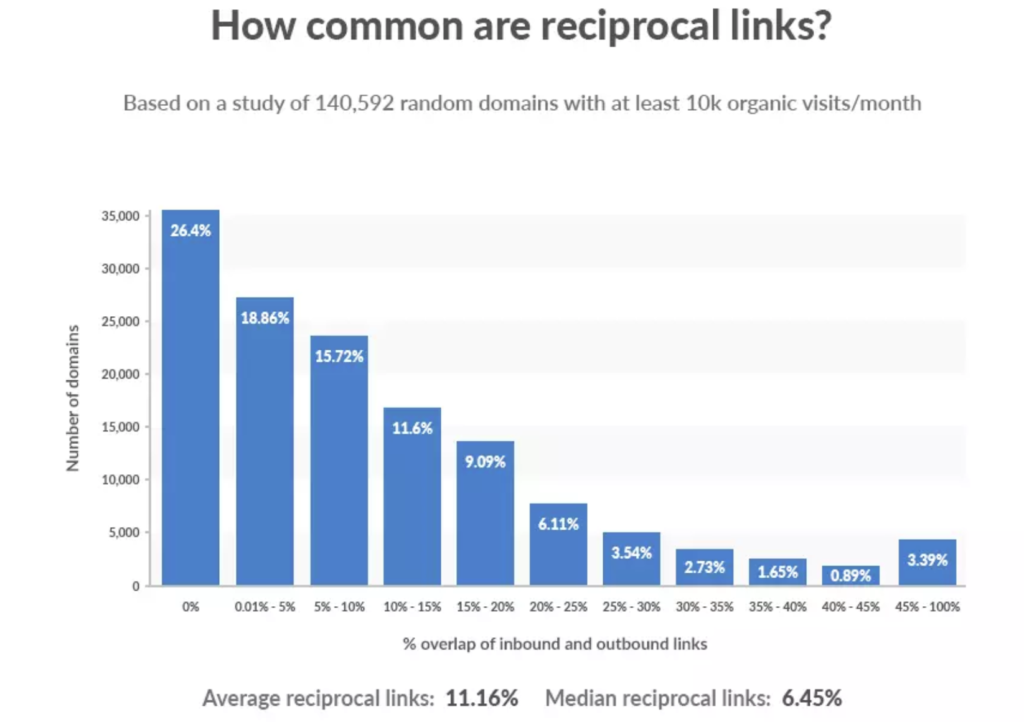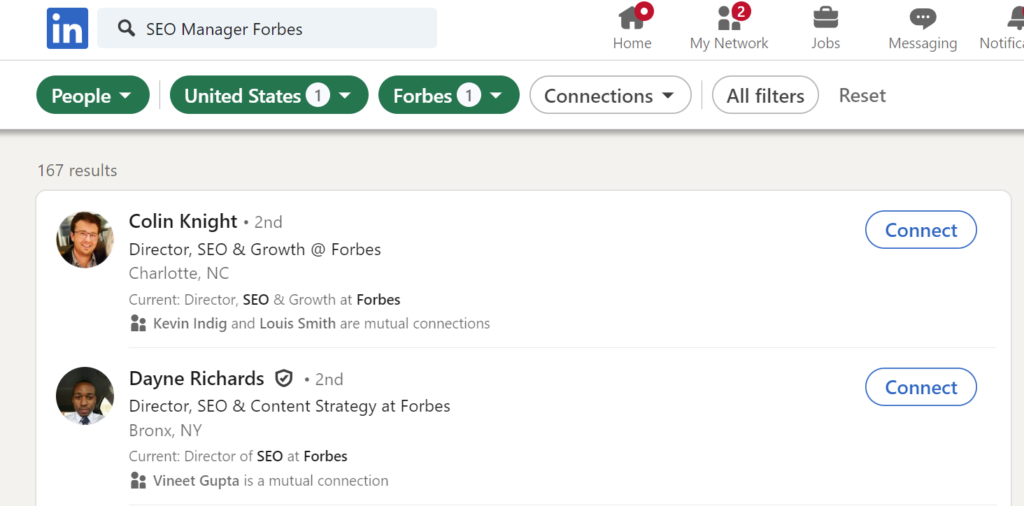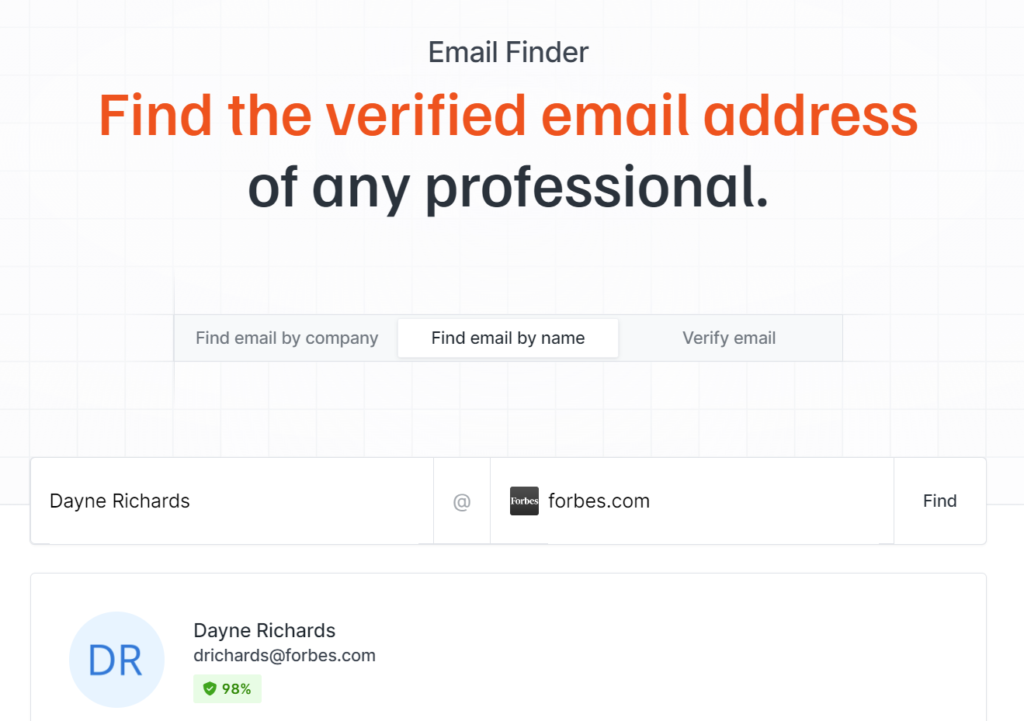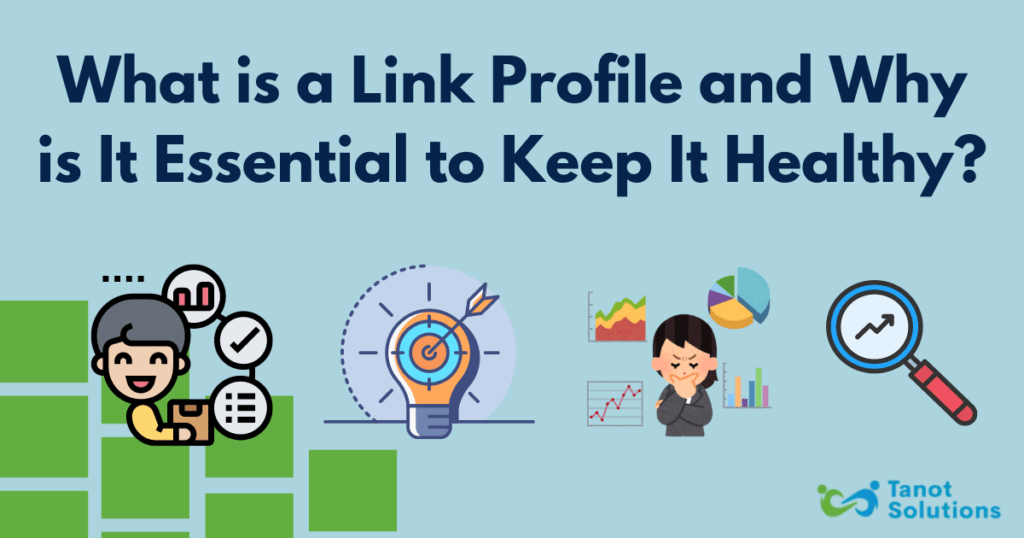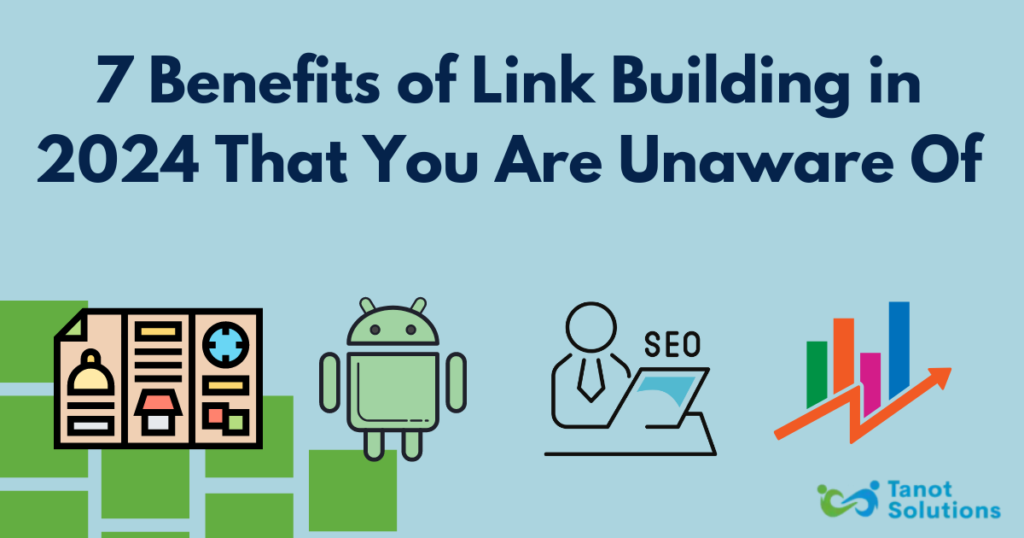A link exchange is when two or more websites agree to link to each other’s content to improve their search rankings and organic traffic. This practice is also known as reciprocal link building.
Link exchanges can be beneficial when done correctly. They allow participants to earn free or affordable backlinks to their web pages and pass on link equity to everyone involved.
However, Google’s John Mueller said that deliberate irrelevant link exchanges between two or more websites, aimed to manipulate search engine rankings are against Google’s webmaster guidelines.
Even if the swap links are topically relevant but they are not natural links to your website; they are part of a deal between you and your linking website owners. Google will see you as someone trying to manipulate search rankings and penalize your website for exchanging links.
So, how can you do link exchanges without being penalized for swapping links? That’s what we’ll cover in this article. Read on to learn how to approach link exchanges from authoritative sites to improve search engine rankings while adhering to Google’s guidelines on link building.
The Best Way to Do Link Exchanges to Boost Your Search Engine Rankings
There are two key link exchange methods — reciprocal and non-reciprocal. Let’s discuss these types of link exchanges briefly and then decide which link building strategy is better for your search engine optimization.
Building reciprocal links
Reciprocal link building is a tactic where two websites do transactional two-way direct link exchanges. This means that website A links to website B and vice versa. This is not a legitimate SEO strategy because excessive reciprocal linking might get your site penalized and hurt your SEO.
This doesn’t mean that you should not link to websites that are linking to you. Instead, you should prioritize link quality and relevance. If the links are topically and contextually relevant, go ahead and link back to reputable websites and also build links from them to relevant content on your own website.
A study by Ahrefs shows that reciprocal links are very common, so you can use these sometimes.
However, don’t force reciprocal links, and don’t overuse link exchange strategy to manipulate rankings. Focus on building valuable backlinks that benefit readers while passing on quality link juice to your site.
Building non-reciprocal links
This link building strategy involves three or more websites giving contextually relevant links to each other indirectly. It is also known as three way link exchanges from other websites.
For example, as the owner of website A, you’ll add a link to a resource on website B. Then, your link partner (website B) will add your website A’s link to a page on website C. These link swaps are indirect and help you scale your link building efforts naturally.
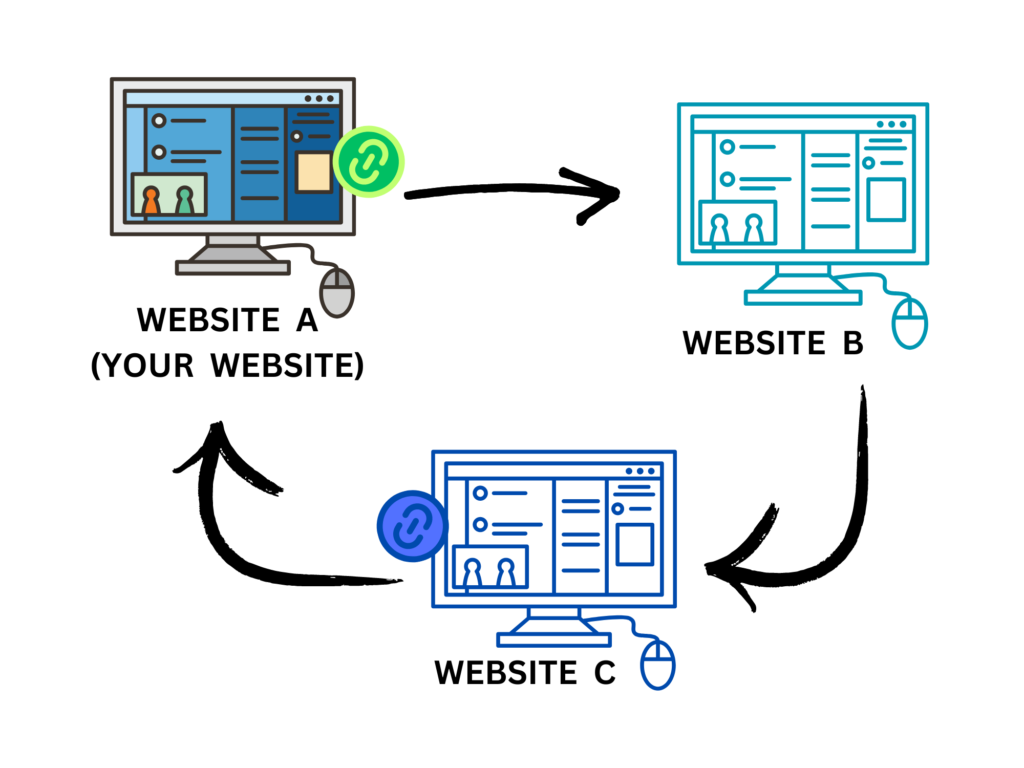
Which is better: Reciprocal or non-reciprocal link exchange?
As there’s no transactional, two-way link exchange, the A-B-C method of exchanging links looks more natural. It’s more difficult for search engine algorithms to catch and penalize such link exchanges.
Still, you can use both methods to exchange links as long as you only provide and seek contextual links and add them naturally within the content.
How to Do A-B-C Link Exchanges the Right Way
In this section, we’ll discuss how you can do A-B-C link exchanges without hurting your website’s SEO and domain rating.
1. Find relevant websites or link exchange partners
The first step is to find relevant websites whose content is closely related to yours. To build relevant and contextual links, you need to find websites within your niche that have content similar to yours.
Here are a few tips to find relevant link exchange partners and websites:
- Search for broad keywords related to your website or niche and see which websites rank on search engine results pages. Use queries like “keyword + link exchange” and “keyword + submit link” to find websites that are open to doing a link exchange.
- Use SEO tools like Semrush or Ahrefs to find websites that are linking to your direct competitors.
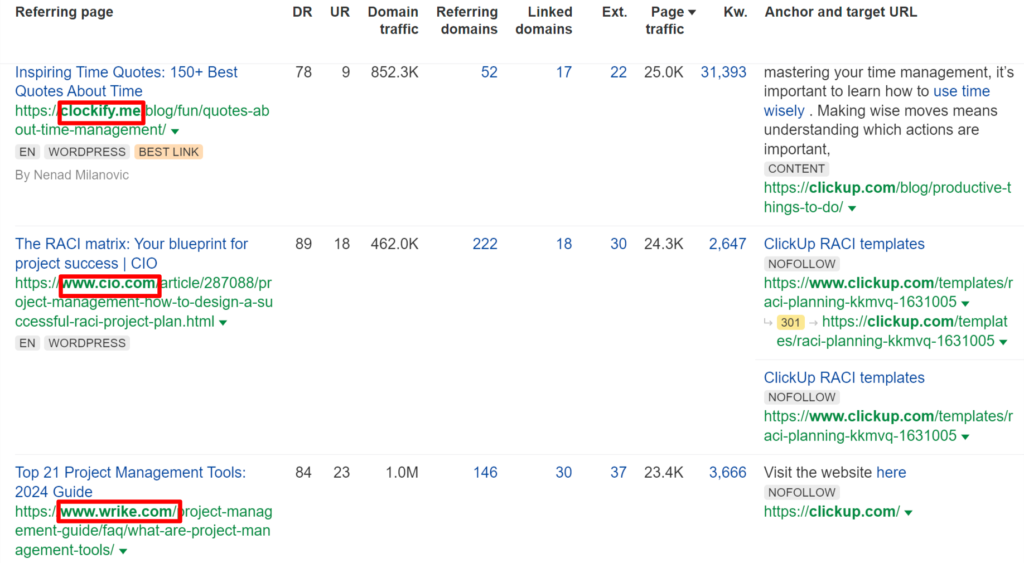
- Leverage link building services to find potential partners and website owners to exchange links through relevant content.
- Join LinkedIn, Slack, and Facebook Groups related to your niche to build industry relationships and organically find link exchange partners.
2. Find the right contact person for the selected websites
After your initial research, you’ll have a long list of websites that can be potential link partners. Check their domain authority, quality of content, link building strategy, and other parameters to shortlist the best websites for a link exchange.
Next, research each shortlisted website to find the right contact person for link exchange. These could be SEO managers, content managers, editors, or authors of those websites.
Let’s say you want to find the right contact person at Forbes. You can search for keywords like “SEO manager Forbes” on LinkedIn. Use the “people” filter to ensure the search results are for people, not jobs.
Select the location and company name to filter out irrelevant results and find the best contacts, as shown in the image below.
Check out all the relevant profiles and read the job descriptions to find the right person to pitch for a link exchange.
3. Find the email of the contact person for link exchange
By now, you should have a list of websites and contact persons for each. Now, you need to find the email information of these people to send emails with link exchange requests.
Use contact finder tools like Hunter, Swordfish, Apollo, or Lusha to find contact information.
Hunter, for example, is a simple tool to find the email information of any professional as long as you know the person’s full name and company. Taking the previous example from Forbes, you can search for Dayne Richards’ email address, as shown below.
4. Write personalized emails to these potential link exchange partners
Reach out to the contacts of potential link partners using personalized emails. Don’t just personalize using each recipient’s name, go beyond that.
Research the website and the kind of content it publishes. Mention some specific articles for each website to show your genuine appreciation for their content. This will also convince them that you have done your research and are proposing a genuine collaboration.
Here’s a simple sample outreach email to get you started:
Hi [Name]
Add a personalization by visiting their profile or website.
I publish content on [insert a list of topics] on my website — [insert website URL]. I think we have similar audiences and publish related content, so I thought it would be a good idea to link to each other’s resources.
I think both our audiences will love to read in-depth content on these topics. What do you say? Would you be interested in becoming a link partner? Drop a line and we can take this further.
Looking forward to hearing from you.
Regards,
[Your name]
[Your designation]
5. Offer your websites for link exchanges and request your link addition
Once you get a response to your first email, discuss the specifics of link exchanges in your follow-up emails.
Suggest specific content pieces and resources on your website that they may find useful. If you own multiple websites, ask for links to one and provide them with backlinks from your other sites.
This link sharing tactic will ensure that there’s no direct link exchange. If you have other link partners, you can create a network of partners who regularly exchange links to each others’ websites, without a direct exchange.
6. Get your link live and make their link live
Discuss the terms of your partnership and start swapping links naturally through link insertions and guest posts.
Swap guest posts among your network of link partners. You and your link exchange partners can also contribute guest posts on various websites and include a link to each other’s websites, not just yours.
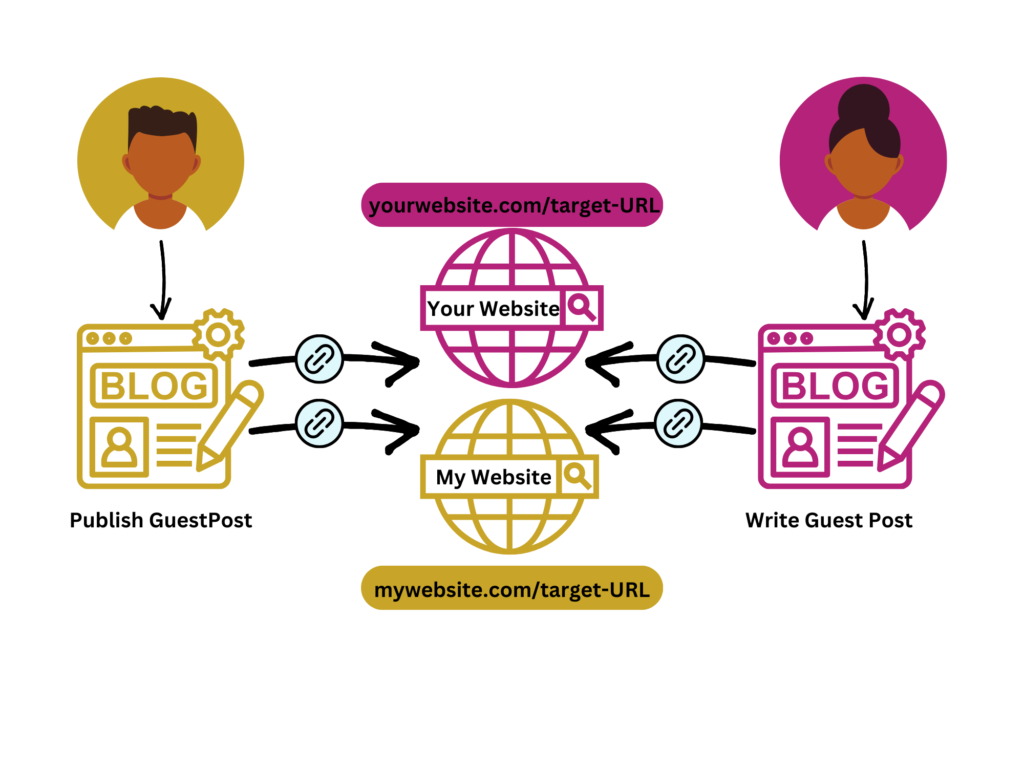 This diversity in referring domains signals to search engines that your websites are valuable.
This diversity in referring domains signals to search engines that your websites are valuable.
Tips for Doing Link Exchanges Safely
Here are some more tips for doing link exchanges safely:
- Prioritize relevance. Search engines consider relevance when looking at backlinks. Exchanging links with an irrelevant website or an irrelevant anchor text won’t bring any value and might even hurt your search rankings.
- Avoid link-farm websites and PBNs (private blog networks that are websites owned or managed by the same person/company) with dangerous outbound link ratios.
- Choose well-established websites that are at least a couple of years old and have a healthy link profile. Check the TrustRank of the linking domains.
- Keep it natural. Refrain from doing reciprocal linking. Keep the number of exchanged links to a minimum compared to the overall backlink profile of your website.
Key Takeaway: Avoid Excessive Link Exchanges That Don’t Look Natural
Link exchanges do not need to be transactional. If done right, A-B-C link exchanges can help you acquire regular high-quality backlinks to your website from reputable sites in your niche.
The key is to build connections and a network of link partners who work together to help each other get relevant backlinks. Of course, you need to pair this link building strategy with high-quality content creation as that’s key to audience engagement.
Use the tips shared in this post to do link exchanges in a way that Google approves. Use smart link exchange methods to build a solid link profile. You can also hire our link building agency to manage your campaigns.

